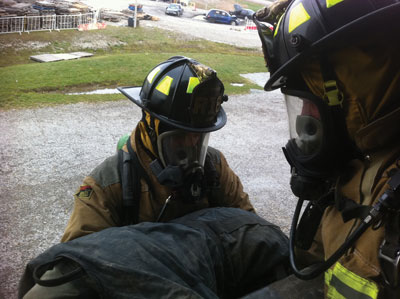
Window rescue for unconscious victims
By Esther Lakatos
Features Structural TrainingHow many times have we heard passionate discussion on how to perform any number of skills in our profession?
How many times have we heard passionate discussion on how to perform any number of skills in our profession? The window rescue is no exception, with its many methods and variations. From the head-out method, to the various feet-first methods, all deserve equal opportunity and praise as long as they deliver and you get the victim out as quickly and safely as possible.
 |
|
| The 2011 recruit class with Vaughan Fire & Rescue Services performs window rescue during training. Photos by Esther Lakatos
|
In the FDNY, VES window rescue, is traditionally performed by a truck company. The FDNY has perfected this skill by entering via ladder, securing the interior door and locating the victim for removal. Having crews search from the interior (with the protection of a hose line) and pass a victim out to another awaiting crew on the exterior can accomplish this same objective. Now you can start to see how this discussion can spark conversations about the many variations.
The window rescue is a firefighting skill that must be practiced, preferably using a live victim who is in harness and on belay. The movements of a victim’s limbs are not easily duplicated with a stiff rescue dummy, and are impossible to realistically replicate using a hose-bundle victim. However, learning this skill for the first time requires repetition and progressive training, and using training victims would be acceptable.
 |
|
| It’s important to practice different methods to know what works best for your department.
|
Using an aerial ladder should be a first option when an elevated egress is required; it is more stable and has a higher load capacity. This is not always possible due to access, location, time of set-up, or simply because the department does not have an aerial apparatus. No need to worry; ground ladders, when properly placed and safely manipulated and secured, can be quickly deployed in narrow places providing elevated egress. If there is a second storey in your municipality, every fire crew should be trained to perform this essential firefighting skill. Firefighters should be knowledgeable with both the heads-out and feet-first methods. You will undoubtedly choose the method that works best for your crew as a working fire rescue team.
Head-out method
- Drag the unconscious victim to the window and place the body supine, knees bent, perpendicular to window with the feet against the wall
- Sit the victim up and pass the victim’s hands to the outside ladder rescuer. Lift the victim from behind up onto the window sill.
- The ladder rescuer will step down onto the rungs and hold onto the beams, ready to receive the victim, with one arm under the victim’s under arm, and the other in-between victim’s legs, once again grasping firmly onto the beam.
- Tip: By lowering the arm on the victim’s lower body, the weight becomes balanced.
- The inside rescuer should not let go of the victim until the ladder rescuer has the victim balanced properly and ready to lower.
- The ladder rescuer steps down the ladder and brings the victim to the ground.
Feet-first method
- Drag the unconscious victim to the window and place body prone, knees bent, perpendicular to window with his knees against the wall.
- Two inside rescuers are required for this manoeuvre.
- The ladder rescuer reaches inside the window, grasping the victim’s ankles, and pulls upwards (this creates a space under the victim’s thighs).
- The inside rescuers place their window-side hands under the victim’s thighs, grasping onto each other’s wrists.
- The inside rescuers grasps under the victim’s chest and, in a co-ordinated manner, lifts the victim.
The legs are received by the ladder rescuer in two possible ways:
1. Diagonally across the body: The legs-end hand goes in between the victim’s legs, then back to holding beam. The top-end hand goes under the victim’s armpit and then back to holding the beam. Balance the weight and proceed down the ladder. This is the same removal process that’s used for a downed firefighter out a window. With a civilian, there is no SCBA strap to grasp. Therefore, you must place that inside hand under the chest and lift with your legs, keeping your back straight.
OR
2. Opened and on knee: Arms go under the victim’s armpits and grasp onto a rung at the victim’s face level. (This prevents the victim’s face from hitting each rung on the way down.) Step down the ladder with same foot leading, one rung at a time, holding the victim’s weight, making sure to keep the victim’s weight on you knee.
There are many variations on the feet-first method such as:
- victim facing ladder rescuer on the rescuer’s knee
- victim facing ladder rescuer diagonally as in (1) above
- victim facing ladder rescuer with legs onto rescuer’s shoulders, rescuer grasping under arm pits and holding onto beam
- Two ladders and two rescuer’s taking one victim down diagonally across their arms.
It is important to practice these skills and work on the most effective method for your crew. Always have a firefighter secure the butt of the ladder below. Train safely!
Esther Lakatos is a 15-year veteran and a captain with Vaughan Fire & Rescue Service in Ontario. She is a platoon trainer in rope rescue and is a trench rescue/confined space technician. Esther has instructed at the Ontario Fire College and is currently an instructor in the pre-service program at Humber College, specializing in live fire and firefighter survival. She is a past Canadian champion in the FireFit combat challenge and a world relay champion. Contact her at esther.lakatos@yahoo.ca
Print this page